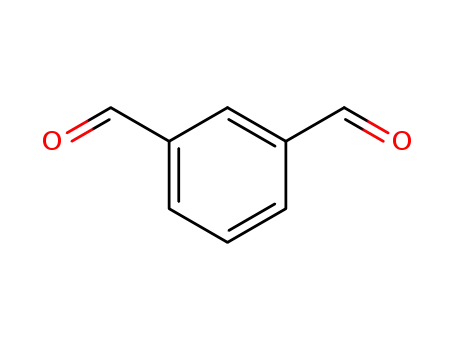Isophthalaldehyde
Synonyms:Isophthalaldede;626-19-7;m-Phthalaldede;1,3-Benzenedicarboxaldede;benzene-1,3-dicarbaldede;Isophthaldede;1,3-benzenedialdede;Isophthaldialdede;Isophtaldedes;Benzene-1,3-dicarboxaldede;Isophtaldedes [French];3-Phthalaldede;Isophthalic dicarboxaldede;MFCD00003372;NSC 5092;EINECS 210-935-8;BRN 1561038;UNII-LU162B2N9X;LU162B2N9X;NSC-5092;4-07-00-02139 (Beilstein Handbook Reference);isophtalaldede;iso-phthalaldede;3-formylbenzaldede;Isophthalaldede, 97%;Benzene 1,3 dicarbaldede;BENZENEDICARBOXALDEHYDE;SCHEMBL180566;CHEMBL2289228;HSDB 8459;DTXSID30870718;NSC5092;BCP24518;AKOS003628495;NCGC00188276-01;30025-33-3;AS-10887;BP-10519;LS-85181;SY007029;AM20061091;CS-0015077;FT-0627448;I0153;EN300-21269;AT-051/40181211;Isophthalaldede, Vetec(TM) reagent grade, 97%;J-521559;Q27283179
Chemical Property of Isophthalaldede
● Appearance/Colour:colourless or light yellow crystals
● Vapor Pressure:0.0164mmHg at 25°C
● Melting Point:87-88 °C(lit.)
● Refractive Index:1.622
● Boiling Point:255.3 °C at 760 mmHg
● Flash Point:94.1 °C
● PSA:34.14000
● Density:1.189 g/cm3
● LogP:1.31160
● Storage Temp.:Store below +30°C.
● Sensitive.:Air Sensitive
● Solubility.:Chloroform (Slightly), Etl Acetate (Slightly)
● Water Solubility.:Slightly soluble in water.
● XLogP3:1.2
● Hydrogen Bond Donor Count:0
● Hydrogen Bond Acceptor Count:2
● Rotatable Bond Count:2
● Exact Mass:134.036779430
● Heavy Atom Count:10
● Complexity:117
Safty Information
● Pictogram(s):
● Hazard Codes:
● Safety Statements:22-24/25
Useful
Canonical SMILES:C1=CC(=CC(=C1)C=O)C=O
Uses:Isophthalaldede is used in the synthesis of binuclear ruthenium complex. It participates in base-catalyzed Knoevenagel condensation reaction. Isophthalaldede is used in the synthesis of binuclear ruthenium complex.
Detailed Introduction
Isophthalaldede, also known as 1,3-benzene dicarboxaldede, is an organic compound with the chemical formula C8H6O2. It is a colorless to pale yellow liquid with a strong, sweet almond-like odor. Isophthalaldede is a structural isomer of terephthalaldede.
Synthesis: Isophthalaldede can be synthesized through the oxidation of m-xylene or p-xylene using various methods. Some common methods include air oxidation, nitric acid oxidation, or metal-catalyzed oxidation.
Application
Chemical Industry: Isophthalaldede serves as a versatile building block for the synthesis of various chemicals and compounds. It reacts with different reagents to produce derivatives such as amines, alcohols, or acids.
Pharmaceutical Industry: Isophthalaldede is used as a starting material in the synthesis of active pharmaceutical ingredients (APIs) or key intermediates in the production of drugs. It can be used in the development of antiviral, antibacterial, or antifungal agents.
Polymer Industry: Isophthalaldede finds application in the production of polymers such as polyesters, polyimides, polyurethanes, and resins. It can be used as a monomer or as a cross-linking agent. Polymers made from isophthalaldede exhibit enhanced thermal stability, mechanical strength, and chemical resistance.
Research and Development: Isophthalaldede is used in laboratory research for organic synthesis, particularly in the development of new compounds or materials. It can also be used in the preparation of ligands for coordination chemistry or as a catalyst in various chemical reactions.
Flavor and Fragrance Industry: Isophthalaldede has a distinct sweet almond-like odor, making it valuable as a fragrance component or flavoring agent in the cosmetic, perfumery, and food industries. It is commonly used in artificial almond flavors and fragrances.
It’s important to note that the applications of isophthalaldede may vary depending on the specific requirements of different industries and further research. Always consult scientific literature, regulatory guidelines, and professionals before using or considering the application of isophthalaldede in a specific field.
Professional technical engineer dedicated to guide you
According to your actual needs, choose the most reasonable overall design and planning procedures
